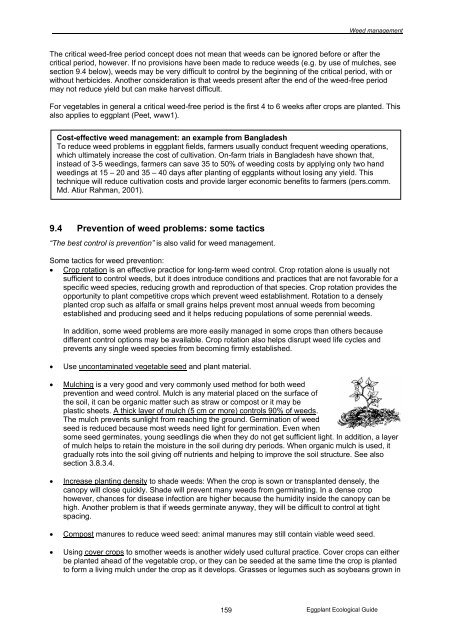Eggplant Integrated Pest Management AN ECOLOGICAL GUIDE
Eggplant Integrated Pest Management AN ECOLOGICAL GUIDE
Eggplant Integrated Pest Management AN ECOLOGICAL GUIDE
You also want an ePaper? Increase the reach of your titles
YUMPU automatically turns print PDFs into web optimized ePapers that Google loves.
________________________________________________________________________________________Weed managementThe critical weed-free period concept does not mean that weeds can be ignored before or after thecritical period, however. If no provisions have been made to reduce weeds (e.g. by use of mulches, seesection 9.4 below), weeds may be very difficult to control by the beginning of the critical period, with orwithout herbicides. Another consideration is that weeds present after the end of the weed-free periodmay not reduce yield but can make harvest difficult.For vegetables in general a critical weed-free period is the first 4 to 6 weeks after crops are planted. Thisalso applies to eggplant (Peet, www1).Cost-effective weed management: an example from BangladeshTo reduce weed problems in eggplant fields, farmers usually conduct frequent weeding operations,which ultimately increase the cost of cultivation. On-farm trials in Bangladesh have shown that,instead of 3-5 weedings, farmers can save 35 to 50% of weeding costs by applying only two handweedings at 15 – 20 and 35 – 40 days after planting of eggplants without losing any yield. Thistechnique will reduce cultivation costs and provide larger economic benefits to farmers (pers.comm.Md. Atiur Rahman, 2001).9.4 Prevention of weed problems: some tactics“The best control is prevention” is also valid for weed management.Some tactics for weed prevention:• Crop rotation is an effective practice for long-term weed control. Crop rotation alone is usually notsufficient to control weeds, but it does introduce conditions and practices that are not favorable for aspecific weed species, reducing growth and reproduction of that species. Crop rotation provides theopportunity to plant competitive crops which prevent weed establishment. Rotation to a denselyplanted crop such as alfalfa or small grains helps prevent most annual weeds from becomingestablished and producing seed and it helps reducing populations of some perennial weeds.In addition, some weed problems are more easily managed in some crops than others becausedifferent control options may be available. Crop rotation also helps disrupt weed life cycles andprevents any single weed species from becoming firmly established.• Use uncontaminated vegetable seed and plant material.• Mulching is a very good and very commonly used method for both weedprevention and weed control. Mulch is any material placed on the surface ofthe soil, it can be organic matter such as straw or compost or it may beplastic sheets. A thick layer of mulch (5 cm or more) controls 90% of weeds.The mulch prevents sunlight from reaching the ground. Germination of weedseed is reduced because most weeds need light for germination. Even whensome seed germinates, young seedlings die when they do not get sufficient light. In addition, a layerof mulch helps to retain the moisture in the soil during dry periods. When organic mulch is used, itgradually rots into the soil giving off nutrients and helping to improve the soil structure. See alsosection 3.8.3.4.• Increase planting density to shade weeds: When the crop is sown or transplanted densely, thecanopy will close quickly. Shade will prevent many weeds from germinating. In a dense crophowever, chances for disease infection are higher because the humidity inside the canopy can behigh. Another problem is that if weeds germinate anyway, they will be difficult to control at tightspacing.• Compost manures to reduce weed seed: animal manures may still contain viable weed seed.• Using cover crops to smother weeds is another widely used cultural practice. Cover crops can eitherbe planted ahead of the vegetable crop, or they can be seeded at the same time the crop is plantedto form a living mulch under the crop as it develops. Grasses or legumes such as soybeans grown in159<strong>Eggplant</strong> Ecological Guide




![Section 4 [ PDF file, 252 KB] - The Field Alliance](https://img.yumpu.com/51387260/1/158x260/section-4-pdf-file-252-kb-the-field-alliance.jpg?quality=85)











